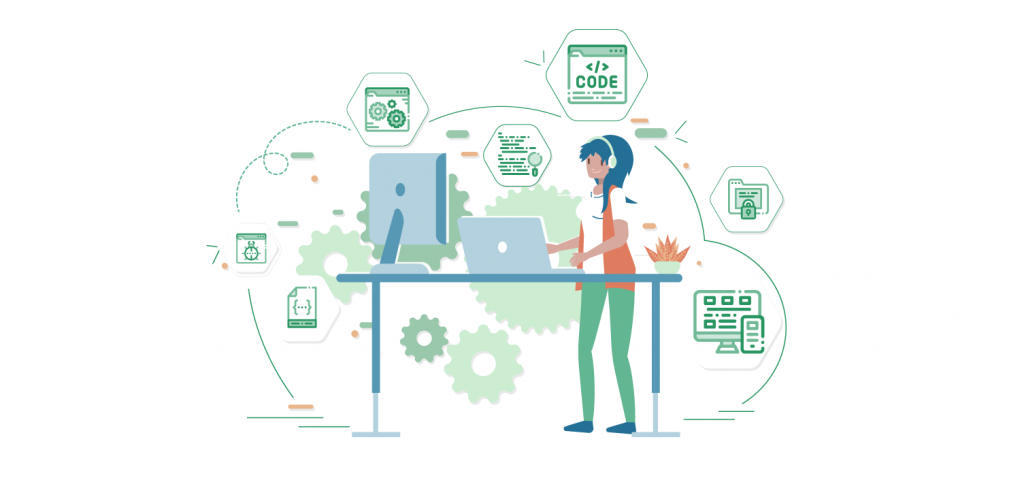Last year, Inclusive Boards released a report that detailed that “women make up only 13% of Board and executive positions within the engineering sector”. Also, according to Women In Tech, “Only one in six tech specialists in the UK are women, only one in ten are IT leaders and […] female representation in the technology sector has stalled over the last 10 years.” These case studies showcase an incredible need to not only encourage women to start careers in tech and engineering, but also for companies to advocate for those that do.
There are many theories as to why there are so few women in tech. Causes can be linked back to the 80s when computers were marketed as toys to boys, to lack of encouragement in nursery and all the way up to a lack of gender equity and equality in the engineering and tech industries.
Women In Engineering at Healthera
It’s important that tech companies like Healthera ensure that we are working to improve equality within our industries. We are aware of the fully qualified women engineers available, and strive to ensure that they are given the same opportunities men are. This extends to all aspects of employment with us, ranging from hiring, inclusivity and acknowledgement.
We sat down with our very own inspiring Women In Engineering, Somia and Suchitra, to tell us a little bit about their careers.

???? How did you start out in engineering?
Somia: I studied Computer Science at University and ended up graduating with a Masters Degree. Although I learned the theory and was only able to put it into practice when I started working.
Suchitra: My brother did Computer Science as well. It was him and my parents that motivated me to get into software engineering. But I wanted to be different from my brother, so I decided to study Electronics and Communications Engineering at university instead. But then after 7 years I decided to retrain in software, so I should have just done Computer Science haha.
???? Did you have any setbacks?
Somia: I did take a break around 5 or 6 years into my career to raise my daughter. But I didn’t want to lose any skills, so I worked remotely to continue training and staying up to date until I could return to the office.
???? Did you find that there was an unequal gender gap when you started your career?
Somia: Not in India, it’s mixed.
Suchitra: It’s diverse and competitive so I never felt like women shouldn’t be doing it.
???? What about when you came to England?
Suchitra: In my first engineering job here, there were about 5 or 6 women out of a team of 75.
Somia: There are definitely a lot more men in engineering here. But I’ve never experienced difficulty because of it.
???? So what does your day to day job look like at Healthera?
Suchitra: As a senior QA, my job involves reviewing and providing feedback on mobile designs , identifying the gaps in the requirements, preparing and prioritising test cases, There is a lot of teamwork and coordination involved within QA and with the developers. I help with functional testing, API backend testing, E2E testing and Regression testing before Go-Live.
Somia: I am an Android mobile app developer. As our projects are in Agile, my daily job includes application development and deployment, sprint planning, requirements and design review meetings.
???? What are the engineering challenges that you enjoyed the most at Healthera?
Suchitra: With Healthera being a startup that’s growing quickly, everything moves quite fast and agile, it has helped me to transition from project to product mindset and also helped me to work faster and become able to change my approaches to suit critical timelines.
Somia: There are also a lot of design challenges; customising views to make them compatible with multiple device configurations. Logic comes easy to me, but the design is where it becomes difficult. I really enjoy doing it though – incorporating the design requirements in android.
???? What has your proudest accomplishment been so far in Healthera?
Suchitra: I’m really passionate about testing. I enjoy identifying issues and breaking the code. I’ve been able to contribute to a lot of QA process improvements so far.
It is rewarding to see my feedback and suggestions are implemented for continuous improvements.
Somia: The company’s technology stack is always up-to-date, so I get to regularly adopt new technology. I’m also proud of delivering quality products and seeing that my community is benefiting from it.
???? Has Healthera helped at all? With you being women in engineering.
Somia: In any of the companies I’ve worked for, I have never sat back because I am a woman, and I have always been able to stand with the men. But in Healthera it’s much easier because they treat everyone as equal here.
Suchitra: Yes, we’re never left out of anything, and it’s nice because they’re always there to support and help.
???? Final thoughts for women that want to get into engineering?
Somia: Not just engineering, women can excel in any field that they set their eyes on. Engineering is definitely a field where the capabilities of women are considered on par with anyone else.
Suchitra: Yes, it’s not something you should feel afraid of doing.
Famous Women In Engineering
While we continue to advocate for women in modern engineering, it’s important to acknowledge and appreciate the women those of the past that have made incredible contributions to the world through their engineering and technological skills.
These include, but are absolutely not limited to:
Ada Lovelace
Lovelace was a 19th-century mathematician, and the first computer programmer. She is credited with seeing the use of the analytical engine beyond mathematical and analytical use, while working with mathematician Charles Babbage. It is believed that she worked out how to use the Engine to perform the first algorithms. Lovelace’s contributions to computer science weren’t recognised for years after her death, but she was honoured posthumously.
Mary Anderson
After noticing that a tram driver in 1902 was having to keep the panes of the front window open to see through sleet, Anderson worked with a designer to develop a manual device to clear snow, ice or sleet from windscreens. Her invention was patented in 1903, but was considered to not have any practical value. Although windshield wipers became standard equipment, and then in 1917 Charlotte Bridgwood patented the first automatic windscreen wiper, Anderson never profited from her invention.
Alice Parker
Not much is known about Parker, an african-american woman that came up with a gas-powered heating system for homes, that allowed the heat to spread. She was granted a patent in 1919 for this invention, which we can thank for our modern central heating systems.
Hedy Lamarr
Lamarr, an actress, film producer and inventor in the 1930s and 40s, invented a technique to allow the US military to control devices remotely. She filed this patent with co-inventor George Antheil so that the military’s communications could hop to different frequencies to prevent them being detected by the Nazis. Although this contribution was acknowledged, she was never paid for it. This technology forms the basis for many secure wireless communication systems, including WiFi, Bluetooth and GPS.
Katharine Burr Blodgett
Blodgett, the first woman in history to earn a Ph.D in Physics from Cambridge University, was an inventor in molecular engineering. Her inventions included low-reflectant invisible glass. This would then be applied to eyeglasses, and lenses used for cinematography. Blodgett’s findings are used to improve other products, such as telescopes, non-reflective store windows, and non-scratch camera lenses.
Patricia Bath
Bath was the first African American to complete a residency in ophthalmology, NYU’s first female to lead an ophthalmology post-graduate program and the first African American doctor to receive a medical patent. In 1976, Bath co-founded the American Institute for the Prevention of Blindness, due to her belief that sight was a basic human right. Then in 1986, she invented the Laserphaco Probe for cataract treatment, the purpose of which was to use lasers to create a less painful and more precise treatment for cataracts. This invention led to restoring the sight of people who had been blind for over 30 years.
For many of these women, and others like them, gaining opportunities and receiving respect and acknowledgement for their knowledge and contributions was an uphill battle. While we have come a long way, we still have more work to do.
Healthera
Healthera operates a leading healthcare marketplace that provides patients with medicines, healthcare services and products through the largest digital platform of pharmacies and GPs in the UK, including national chains and independent providers. Download Healthera App to order NHS repeat prescription online!


